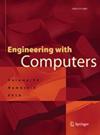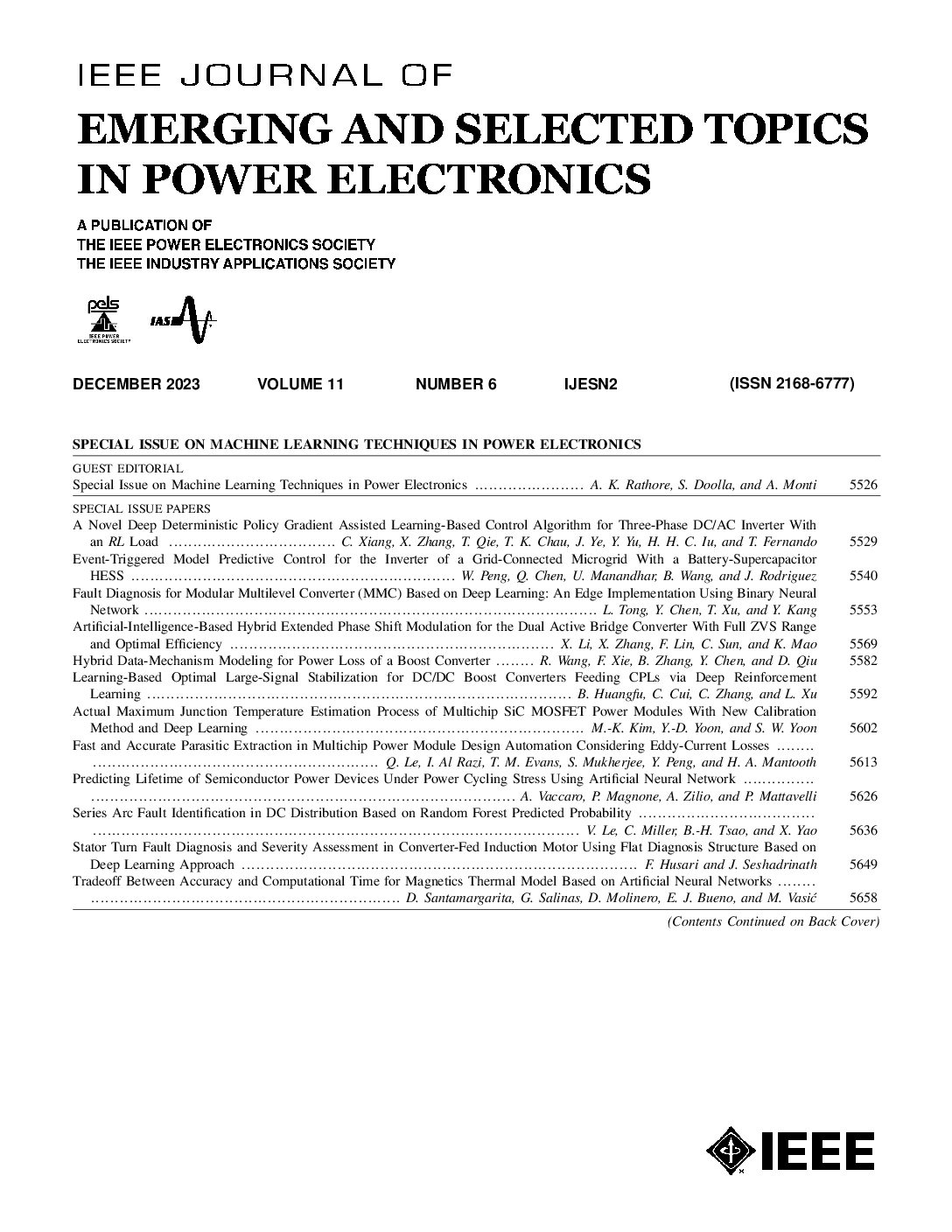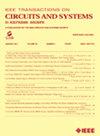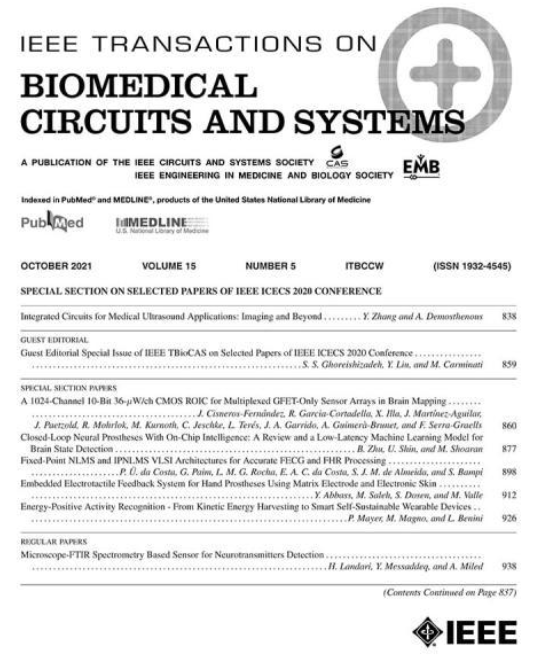中文名称:
等纳米生物技术
期刊缩写:
IET Nanobiotechnol.
影响因子:
4.9
ISSN:
print: 1751-8741
on-line: 1751-875X
on-line: 1751-875X
研究领域:
工程技术-纳米科技
创刊年份:
2007年
h-index:
31
自引率:
4.30%
Gold OA文章占比:
69.12%
原创研究文献占比:
90.63%
SCI收录类型:
Science Citation Index Expanded (SCIE) || Scopus (CiteScore) || Directory of Open Access Journals (DOAJ)
期刊官网:
期刊介绍英文:
Electrical and electronic engineers have a long and illustrious history of contributing new theories and technologies to the biomedical sciences. This includes the cable theory for understanding the transmission of electrical signals in nerve axons and muscle fibres; dielectric techniques that advanced the understanding of cell membrane structures and membrane ion channels; electron and atomic force microscopy for investigating cells at the molecular level.
Other engineering disciplines, along with contributions from the biological, chemical, materials and physical sciences, continue to provide groundbreaking contributions to this subject at the molecular and submolecular level. Our subject now extends from single molecule measurements using scanning probe techniques, through to interactions between cells and microstructures, micro- and nano-fluidics, and aspects of lab-on-chip technologies. The primary aim of IET Nanobiotechnology is to provide a vital resource for academic and industrial researchers operating in this exciting cross-disciplinary activity. We can only achieve this by publishing cutting edge research papers and expert review articles from the international engineering and scientific community. To attract such contributions we will exercise a commitment to our authors by ensuring that their manuscripts receive rapid constructive peer opinions and feedback across interdisciplinary boundaries.
IET Nanobiotechnology covers all aspects of research and emerging technologies including, but not limited to:
Fundamental theories and concepts applied to biomedical-related devices and methods at the micro- and nano-scale (including methods that employ electrokinetic, electrohydrodynamic, and optical trapping techniques)
Micromachining and microfabrication tools and techniques applied to the top-down approach to nanobiotechnology
Nanomachining and nanofabrication tools and techniques directed towards biomedical and biotechnological applications (e.g. applications of atomic force microscopy, scanning probe microscopy and related tools)
Colloid chemistry applied to nanobiotechnology (e.g. cosmetics, suntan lotions, bio-active nanoparticles)
Biosynthesis (also known as green synthesis) of nanoparticles; to be considered for publication, research papers in this area must be directed principally towards biomedical research and especially if they encompass in vivo models or proofs of concept. We welcome papers that are application-orientated or offer new concepts of substantial biomedical importance
Techniques for probing cell physiology, cell adhesion sites and cell-cell communication
Molecular self-assembly, including concepts of supramolecular chemistry, molecular recognition, and DNA nanotechnology
Societal issues such as health and the environment
Special issues. Call for papers:
Smart Nanobiosensors for Next-generation Biomedical Applications - https://digital-library.theiet.org/files/IET_NBT_CFP_SNNBA.pdf
Selected extended papers from the International conference of the 19th Asian BioCeramic Symposium - https://digital-library.theiet.org/files/IET_NBT_CFP_ABS.pdf
CiteScore:
| CiteScore | SJR | SNIP | CiteScore排名 |
|---|---|---|---|
| 6.2 | 0.512 | 0.707 | 学科 排名 百分位 大类:Engineering 小类:Electrical and Electronic Engineering 202 / 797 74% 大类:Materials Science 小类:Electronic, Optical and Magnetic Materials 77 / 284 73% 大类:Biochemistry, Genetics and Molecular Biology 小类:Biotechnology 116 / 311 62% |
发文信息
中科院SCI期刊分区
2025年3月20日发布
| 大类 | 小类 | TOP期刊 | 综述期刊 |
|---|---|---|---|
| 4区 工程技术 | 4区 生化研究方法 BIOCHEMICAL RESEARCH METHODS 4区 纳米科技 NANOSCIENCE & NANOTECHNOLOGY | 否 | 否 |
2023年12月发布
| 大类 | 小类 | TOP期刊 | 综述期刊 |
|---|---|---|---|
| 4区 工程技术 |
4区
生化研究方法
BIOCHEMICAL RESEARCH METHODS
4区
纳米科技
NANOSCIENCE & NANOTECHNOLOGY
|
否 | 否 |
WOS期刊分区
| 学科分类 |
|---|
Q1BIOCHEMICAL RESEARCH METHODS Q3NANOSCIENCE & NANOTECHNOLOGY |
历年影响因子
| 2016年 | 1.5410 |
|---|---|
| 2017年 | 1.4630 |
| 2018年 | 2.0590 |
| 2019年 | 1.9250 |
| 2020年 | 1.8470 |
| 2021年 | 2.0500 |
| 2022年 | 2.3000 |
| 2023年 | 3.8000 |
| 2024年 | 4.9000 |
历年发表
| 2012年 | 24 |
|---|---|
| 2013年 | 25 |
| 2014年 | 46 |
| 2015年 | 60 |
| 2016年 | 145 |
| 2017年 | 133 |
| 2018年 | 190 |
| 2019年 | 127 |
| 2020年 | 121 |
| 2021年 | 82 |
| 2022年 | 34 |
投稿信息
出版周期:
Bi-monthly
出版语言:
English
出版国家(地区):
ENGLAND
审稿时长:
1 months
出版商:
Wiley
编辑部地址:
WILEY, 111 RIVER ST, HOBOKEN, USA, NJ, 07030-5774
IET nanobiotechnology - 最新文献
A Comprehensive Study on Enhancing Microbicidal Activity of Pure and Ion-Exchanged Zeolites Through Structural and Chemical Determinants
Pub Date : 2025-09-27 DOI: 10.1049/nbt2/7012728 Hadi Tabesh, Shabnam Kharrazi, Mostafa Bashiri Barazandeh, Parastoo Ebadoulah Poursafa, Ali PoorkhalilA Multiomic Study of Platelet-Derived Extracellular Vesicles and Impact of Platelet Concentrate Sources
Pub Date : 2025-08-19 DOI: 10.1049/nbt2/8358424 Andreu Miquel Amengual-Tugores, Carmen Ráez-Meseguer, Maria Antònia Forteza-Genestra, Javier Calvo, Antoni Gayà, Marta Monjo, Joana Maria RamisExamining the Impact of Sonodynamic Therapy With Ultrasound Wave in the Presence of Curcumin-Coated Silver Nanoparticles on the Apoptosis of MCF7 Breast Cancer Cells
Pub Date : 2025-07-15 DOI: 10.1049/nbt2/7036856 Zeinab Hormozi-Moghaddam, Ali Neshasteh-Riz, Seyedeh Mona Taheri, Seyed Mohammad Amini, Ehsan Sedghinezhad
免责声明:
本页显示期刊或杂志信息,仅供参考学习,不是任何期刊杂志官网,不涉及出版事务,特此申明。如需出版一切事务需要用户自己向出版商联系核实。若本页展示内容有任何问题,请联系我们,邮箱:info@booksci.cn,我们会认真核实处理。
本页显示期刊或杂志信息,仅供参考学习,不是任何期刊杂志官网,不涉及出版事务,特此申明。如需出版一切事务需要用户自己向出版商联系核实。若本页展示内容有任何问题,请联系我们,邮箱:info@booksci.cn,我们会认真核实处理。








